Cyber Insurance: An Overview of Benefits, Types, and Challenges
VerifiedAdded on 2020/05/08
|14
|3946
|49
Report
AI Summary
This report provides a comprehensive overview of cyber insurance, detailing its benefits, various types, and the critical needs it addresses. It explores the advantages of cyber insurance in protecting businesses and individuals from internet-based risks, including data destruction, theft, and hacking. The report examines different types of cyber insurance, such as hacksurance, business interruption coverage, and reputation insurance, highlighting their specific functions. It also discusses the needs for cyber insurance, emphasizing the increasing risks posed by cyber threats and the limitations of traditional security measures. Furthermore, the report addresses the issues within current cyber insurance systems, such as correlated risks and information asymmetries, and proposes methods for improving network security and risk management. Finally, it highlights the importance of cyber insurance as a risk management technique, offering valuable insights into the current state of cyber security and the potential of cyber insurance to mitigate cyber threats.
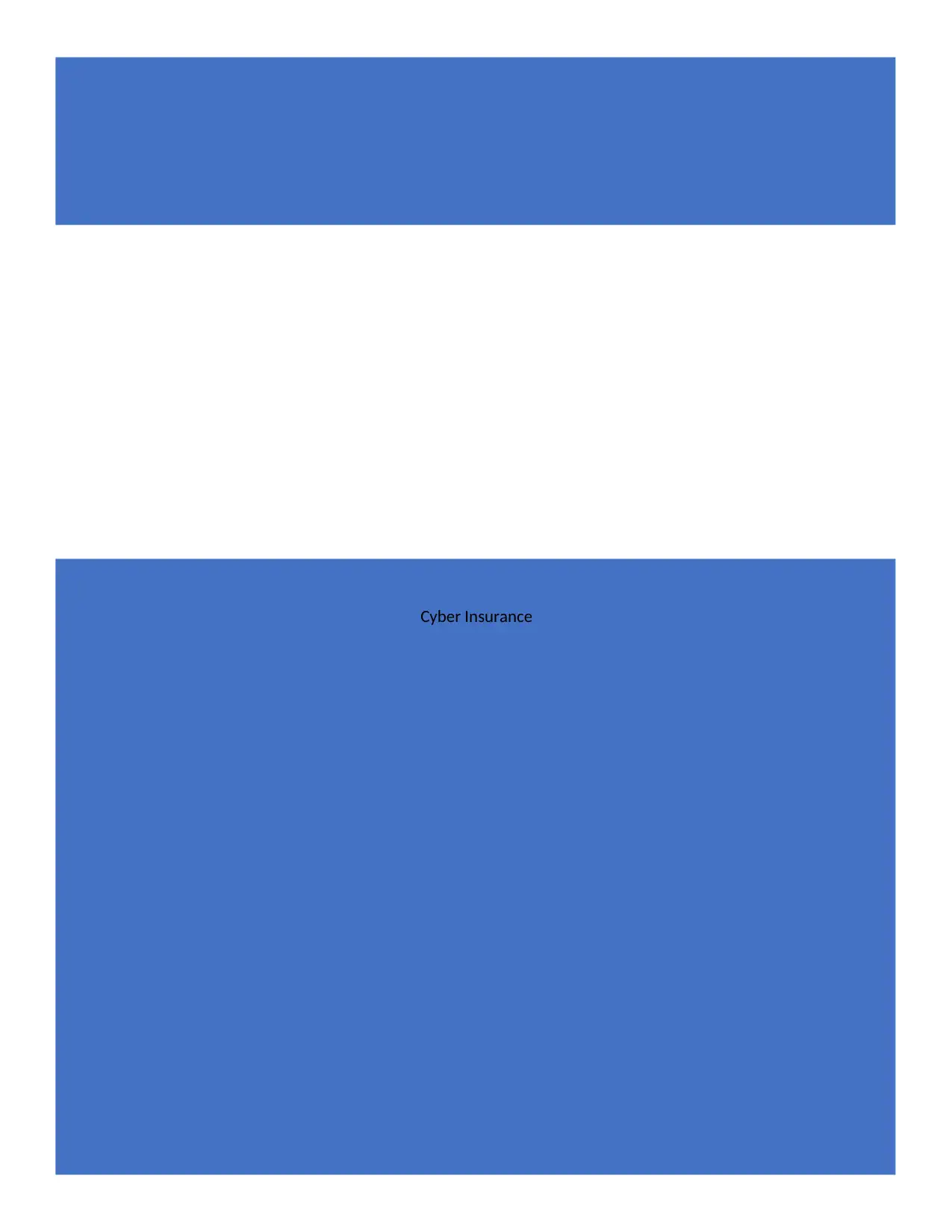
Cyber Insurance
Paraphrase This Document
Need a fresh take? Get an instant paraphrase of this document with our AI Paraphraser
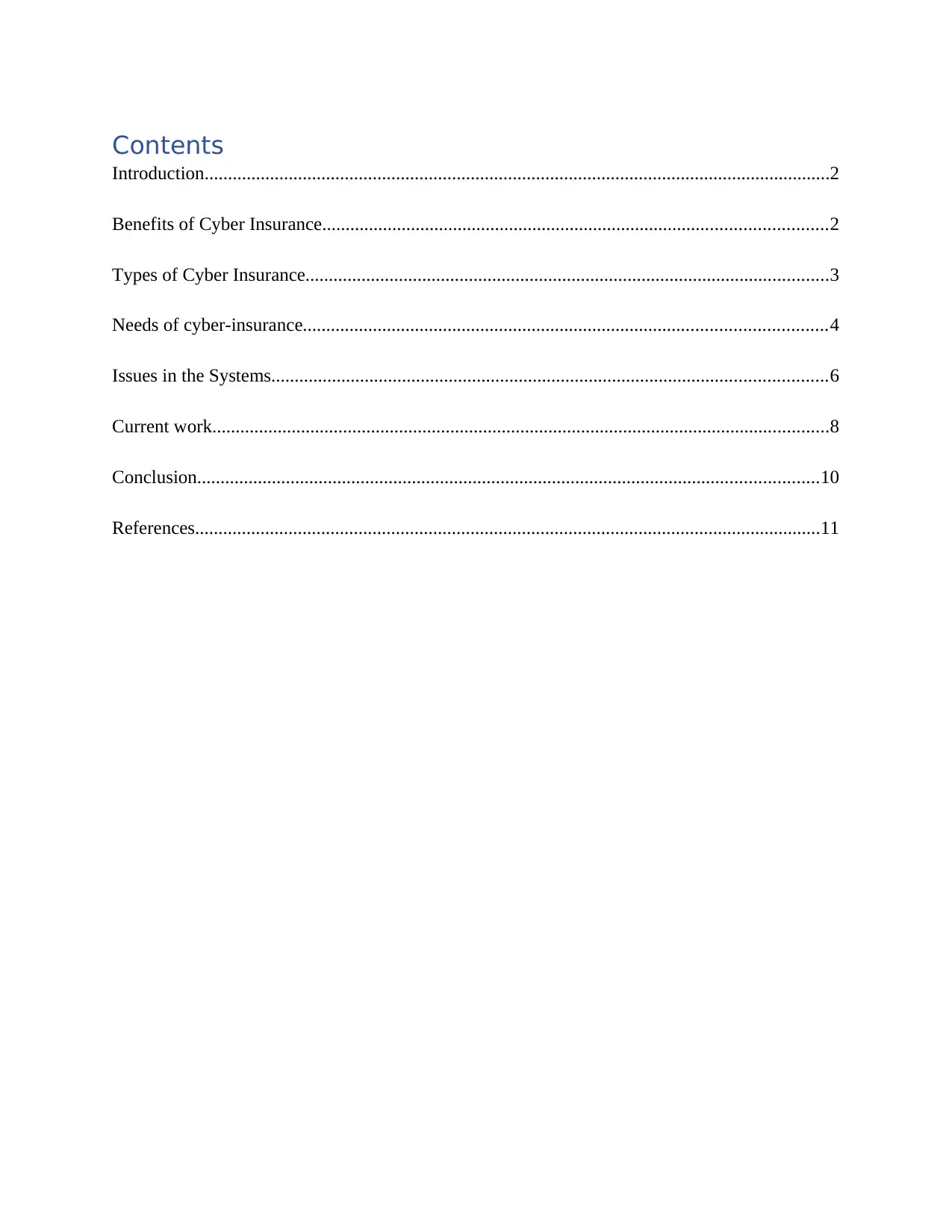
Contents
Introduction......................................................................................................................................2
Benefits of Cyber Insurance............................................................................................................2
Types of Cyber Insurance................................................................................................................3
Needs of cyber-insurance................................................................................................................4
Issues in the Systems.......................................................................................................................6
Current work....................................................................................................................................8
Conclusion.....................................................................................................................................10
References......................................................................................................................................11
Introduction......................................................................................................................................2
Benefits of Cyber Insurance............................................................................................................2
Types of Cyber Insurance................................................................................................................3
Needs of cyber-insurance................................................................................................................4
Issues in the Systems.......................................................................................................................6
Current work....................................................................................................................................8
Conclusion.....................................................................................................................................10
References......................................................................................................................................11
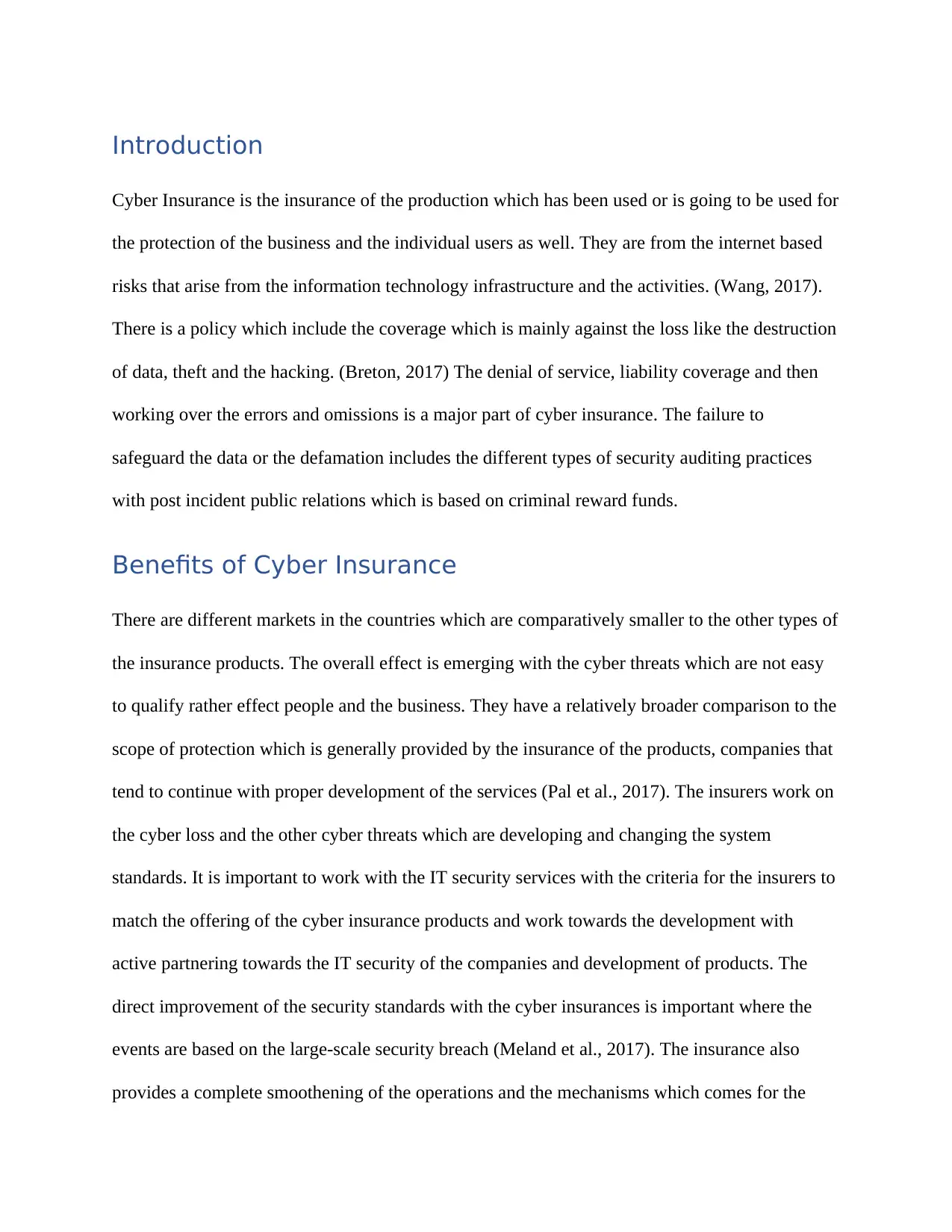
Introduction
Cyber Insurance is the insurance of the production which has been used or is going to be used for
the protection of the business and the individual users as well. They are from the internet based
risks that arise from the information technology infrastructure and the activities. (Wang, 2017).
There is a policy which include the coverage which is mainly against the loss like the destruction
of data, theft and the hacking. (Breton, 2017) The denial of service, liability coverage and then
working over the errors and omissions is a major part of cyber insurance. The failure to
safeguard the data or the defamation includes the different types of security auditing practices
with post incident public relations which is based on criminal reward funds.
Benefits of Cyber Insurance
There are different markets in the countries which are comparatively smaller to the other types of
the insurance products. The overall effect is emerging with the cyber threats which are not easy
to qualify rather effect people and the business. They have a relatively broader comparison to the
scope of protection which is generally provided by the insurance of the products, companies that
tend to continue with proper development of the services (Pal et al., 2017). The insurers work on
the cyber loss and the other cyber threats which are developing and changing the system
standards. It is important to work with the IT security services with the criteria for the insurers to
match the offering of the cyber insurance products and work towards the development with
active partnering towards the IT security of the companies and development of products. The
direct improvement of the security standards with the cyber insurances is important where the
events are based on the large-scale security breach (Meland et al., 2017). The insurance also
provides a complete smoothening of the operations and the mechanisms which comes for the
Cyber Insurance is the insurance of the production which has been used or is going to be used for
the protection of the business and the individual users as well. They are from the internet based
risks that arise from the information technology infrastructure and the activities. (Wang, 2017).
There is a policy which include the coverage which is mainly against the loss like the destruction
of data, theft and the hacking. (Breton, 2017) The denial of service, liability coverage and then
working over the errors and omissions is a major part of cyber insurance. The failure to
safeguard the data or the defamation includes the different types of security auditing practices
with post incident public relations which is based on criminal reward funds.
Benefits of Cyber Insurance
There are different markets in the countries which are comparatively smaller to the other types of
the insurance products. The overall effect is emerging with the cyber threats which are not easy
to qualify rather effect people and the business. They have a relatively broader comparison to the
scope of protection which is generally provided by the insurance of the products, companies that
tend to continue with proper development of the services (Pal et al., 2017). The insurers work on
the cyber loss and the other cyber threats which are developing and changing the system
standards. It is important to work with the IT security services with the criteria for the insurers to
match the offering of the cyber insurance products and work towards the development with
active partnering towards the IT security of the companies and development of products. The
direct improvement of the security standards with the cyber insurances is important where the
events are based on the large-scale security breach (Meland et al., 2017). The insurance also
provides a complete smoothening of the operations and the mechanisms which comes for the
⊘ This is a preview!⊘
Do you want full access?
Subscribe today to unlock all pages.

Trusted by 1+ million students worldwide
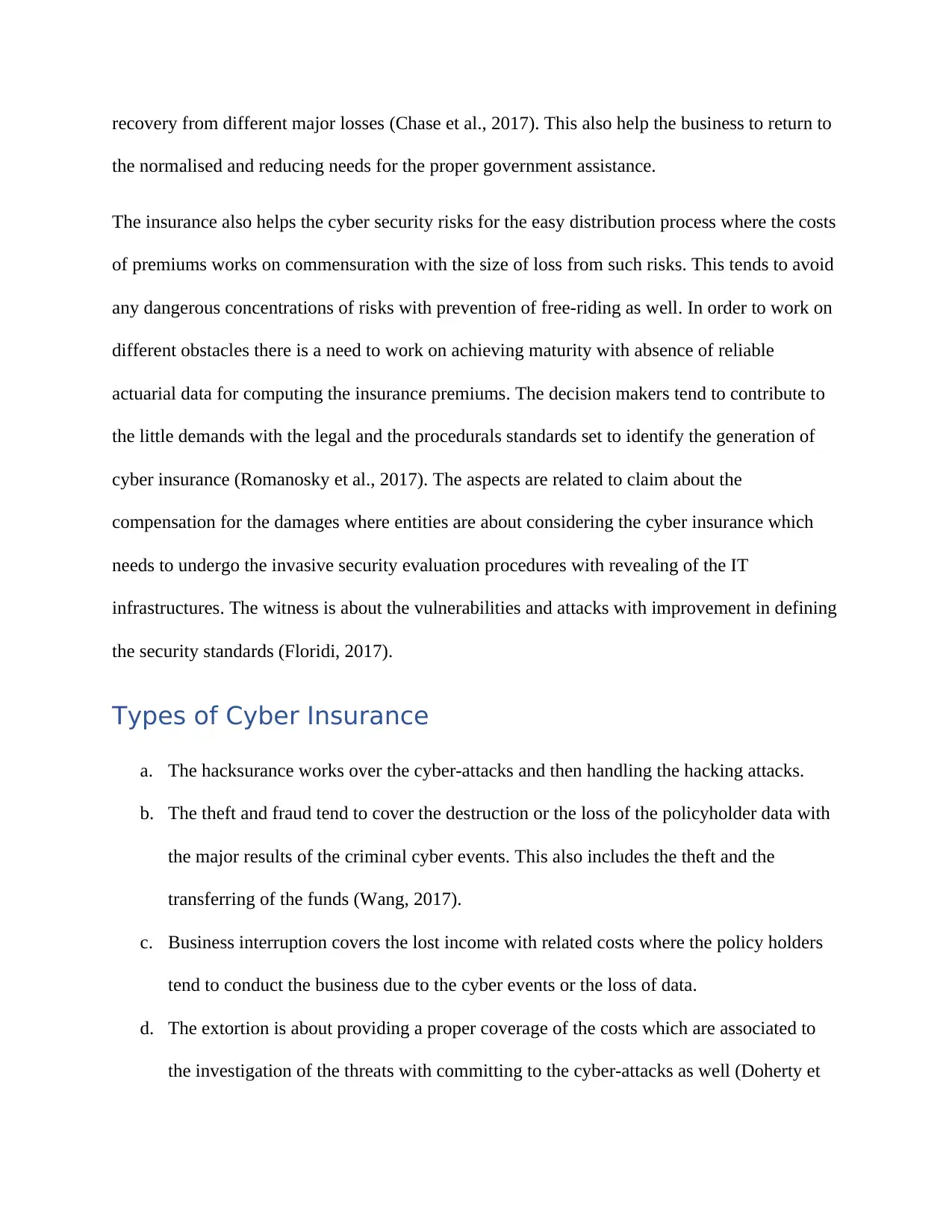
recovery from different major losses (Chase et al., 2017). This also help the business to return to
the normalised and reducing needs for the proper government assistance.
The insurance also helps the cyber security risks for the easy distribution process where the costs
of premiums works on commensuration with the size of loss from such risks. This tends to avoid
any dangerous concentrations of risks with prevention of free-riding as well. In order to work on
different obstacles there is a need to work on achieving maturity with absence of reliable
actuarial data for computing the insurance premiums. The decision makers tend to contribute to
the little demands with the legal and the procedurals standards set to identify the generation of
cyber insurance (Romanosky et al., 2017). The aspects are related to claim about the
compensation for the damages where entities are about considering the cyber insurance which
needs to undergo the invasive security evaluation procedures with revealing of the IT
infrastructures. The witness is about the vulnerabilities and attacks with improvement in defining
the security standards (Floridi, 2017).
Types of Cyber Insurance
a. The hacksurance works over the cyber-attacks and then handling the hacking attacks.
b. The theft and fraud tend to cover the destruction or the loss of the policyholder data with
the major results of the criminal cyber events. This also includes the theft and the
transferring of the funds (Wang, 2017).
c. Business interruption covers the lost income with related costs where the policy holders
tend to conduct the business due to the cyber events or the loss of data.
d. The extortion is about providing a proper coverage of the costs which are associated to
the investigation of the threats with committing to the cyber-attacks as well (Doherty et
the normalised and reducing needs for the proper government assistance.
The insurance also helps the cyber security risks for the easy distribution process where the costs
of premiums works on commensuration with the size of loss from such risks. This tends to avoid
any dangerous concentrations of risks with prevention of free-riding as well. In order to work on
different obstacles there is a need to work on achieving maturity with absence of reliable
actuarial data for computing the insurance premiums. The decision makers tend to contribute to
the little demands with the legal and the procedurals standards set to identify the generation of
cyber insurance (Romanosky et al., 2017). The aspects are related to claim about the
compensation for the damages where entities are about considering the cyber insurance which
needs to undergo the invasive security evaluation procedures with revealing of the IT
infrastructures. The witness is about the vulnerabilities and attacks with improvement in defining
the security standards (Floridi, 2017).
Types of Cyber Insurance
a. The hacksurance works over the cyber-attacks and then handling the hacking attacks.
b. The theft and fraud tend to cover the destruction or the loss of the policyholder data with
the major results of the criminal cyber events. This also includes the theft and the
transferring of the funds (Wang, 2017).
c. Business interruption covers the lost income with related costs where the policy holders
tend to conduct the business due to the cyber events or the loss of data.
d. The extortion is about providing a proper coverage of the costs which are associated to
the investigation of the threats with committing to the cyber-attacks as well (Doherty et
Paraphrase This Document
Need a fresh take? Get an instant paraphrase of this document with our AI Paraphraser
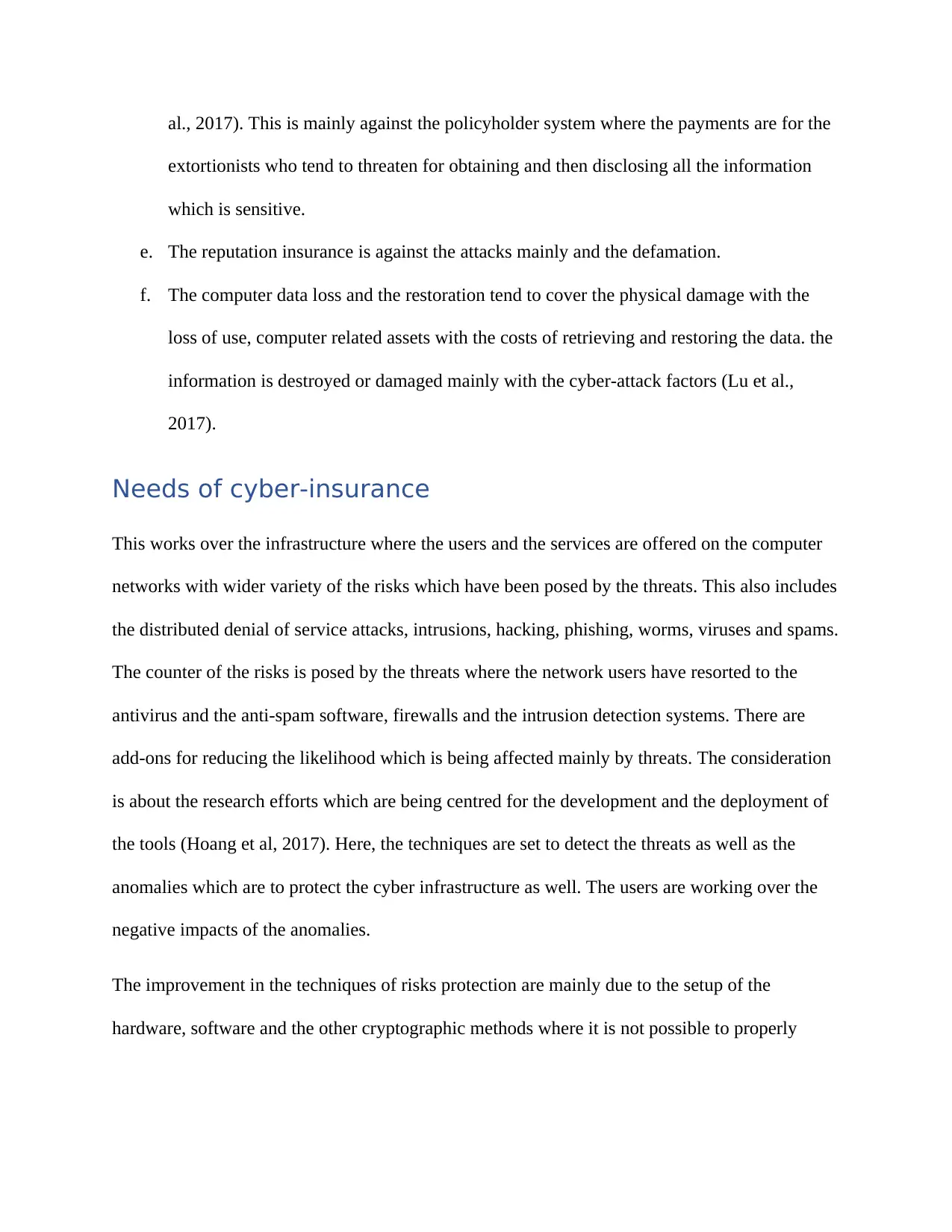
al., 2017). This is mainly against the policyholder system where the payments are for the
extortionists who tend to threaten for obtaining and then disclosing all the information
which is sensitive.
e. The reputation insurance is against the attacks mainly and the defamation.
f. The computer data loss and the restoration tend to cover the physical damage with the
loss of use, computer related assets with the costs of retrieving and restoring the data. the
information is destroyed or damaged mainly with the cyber-attack factors (Lu et al.,
2017).
Needs of cyber-insurance
This works over the infrastructure where the users and the services are offered on the computer
networks with wider variety of the risks which have been posed by the threats. This also includes
the distributed denial of service attacks, intrusions, hacking, phishing, worms, viruses and spams.
The counter of the risks is posed by the threats where the network users have resorted to the
antivirus and the anti-spam software, firewalls and the intrusion detection systems. There are
add-ons for reducing the likelihood which is being affected mainly by threats. The consideration
is about the research efforts which are being centred for the development and the deployment of
the tools (Hoang et al, 2017). Here, the techniques are set to detect the threats as well as the
anomalies which are to protect the cyber infrastructure as well. The users are working over the
negative impacts of the anomalies.
The improvement in the techniques of risks protection are mainly due to the setup of the
hardware, software and the other cryptographic methods where it is not possible to properly
extortionists who tend to threaten for obtaining and then disclosing all the information
which is sensitive.
e. The reputation insurance is against the attacks mainly and the defamation.
f. The computer data loss and the restoration tend to cover the physical damage with the
loss of use, computer related assets with the costs of retrieving and restoring the data. the
information is destroyed or damaged mainly with the cyber-attack factors (Lu et al.,
2017).
Needs of cyber-insurance
This works over the infrastructure where the users and the services are offered on the computer
networks with wider variety of the risks which have been posed by the threats. This also includes
the distributed denial of service attacks, intrusions, hacking, phishing, worms, viruses and spams.
The counter of the risks is posed by the threats where the network users have resorted to the
antivirus and the anti-spam software, firewalls and the intrusion detection systems. There are
add-ons for reducing the likelihood which is being affected mainly by threats. The consideration
is about the research efforts which are being centred for the development and the deployment of
the tools (Hoang et al, 2017). Here, the techniques are set to detect the threats as well as the
anomalies which are to protect the cyber infrastructure as well. The users are working over the
negative impacts of the anomalies.
The improvement in the techniques of risks protection are mainly due to the setup of the
hardware, software and the other cryptographic methods where it is not possible to properly
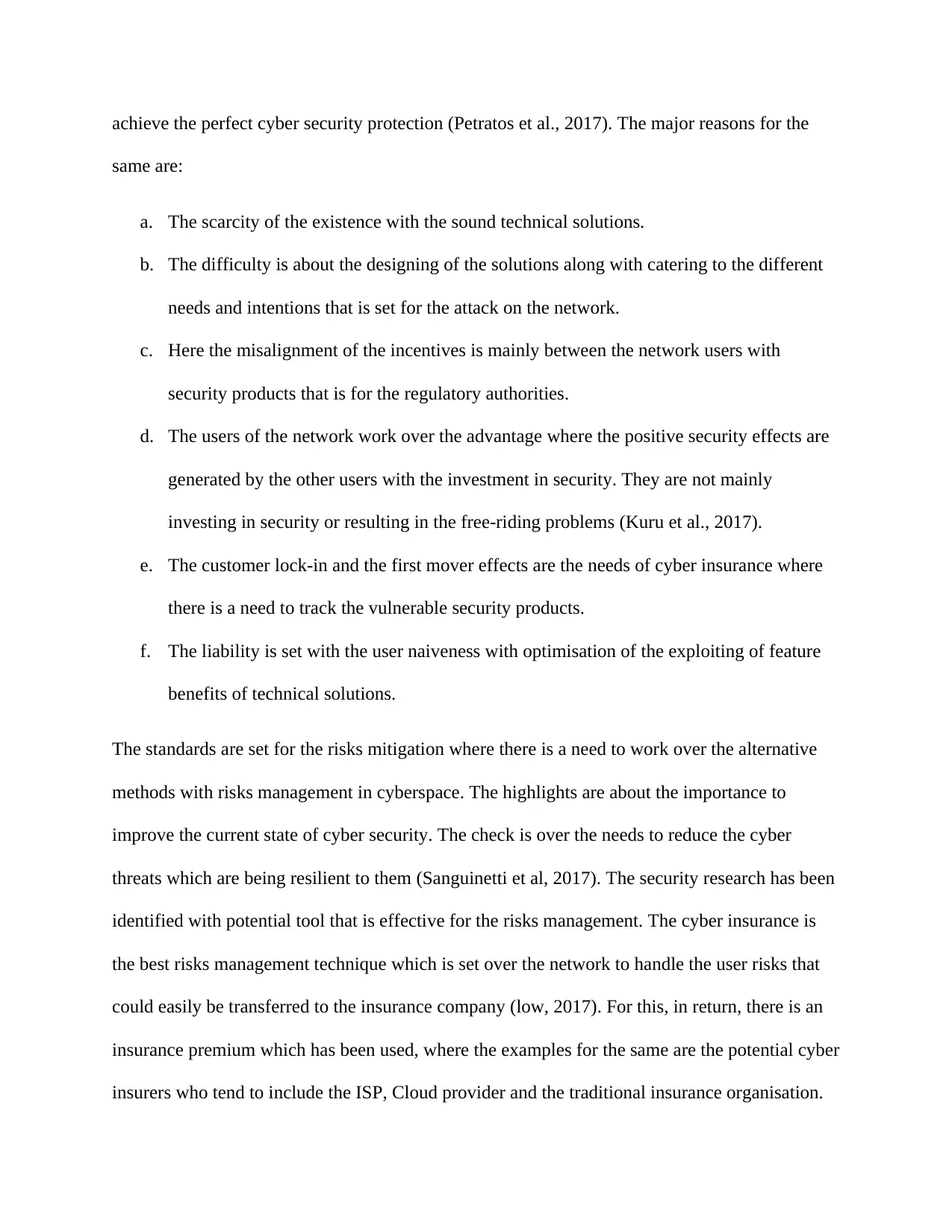
achieve the perfect cyber security protection (Petratos et al., 2017). The major reasons for the
same are:
a. The scarcity of the existence with the sound technical solutions.
b. The difficulty is about the designing of the solutions along with catering to the different
needs and intentions that is set for the attack on the network.
c. Here the misalignment of the incentives is mainly between the network users with
security products that is for the regulatory authorities.
d. The users of the network work over the advantage where the positive security effects are
generated by the other users with the investment in security. They are not mainly
investing in security or resulting in the free-riding problems (Kuru et al., 2017).
e. The customer lock-in and the first mover effects are the needs of cyber insurance where
there is a need to track the vulnerable security products.
f. The liability is set with the user naiveness with optimisation of the exploiting of feature
benefits of technical solutions.
The standards are set for the risks mitigation where there is a need to work over the alternative
methods with risks management in cyberspace. The highlights are about the importance to
improve the current state of cyber security. The check is over the needs to reduce the cyber
threats which are being resilient to them (Sanguinetti et al, 2017). The security research has been
identified with potential tool that is effective for the risks management. The cyber insurance is
the best risks management technique which is set over the network to handle the user risks that
could easily be transferred to the insurance company (low, 2017). For this, in return, there is an
insurance premium which has been used, where the examples for the same are the potential cyber
insurers who tend to include the ISP, Cloud provider and the traditional insurance organisation.
same are:
a. The scarcity of the existence with the sound technical solutions.
b. The difficulty is about the designing of the solutions along with catering to the different
needs and intentions that is set for the attack on the network.
c. Here the misalignment of the incentives is mainly between the network users with
security products that is for the regulatory authorities.
d. The users of the network work over the advantage where the positive security effects are
generated by the other users with the investment in security. They are not mainly
investing in security or resulting in the free-riding problems (Kuru et al., 2017).
e. The customer lock-in and the first mover effects are the needs of cyber insurance where
there is a need to track the vulnerable security products.
f. The liability is set with the user naiveness with optimisation of the exploiting of feature
benefits of technical solutions.
The standards are set for the risks mitigation where there is a need to work over the alternative
methods with risks management in cyberspace. The highlights are about the importance to
improve the current state of cyber security. The check is over the needs to reduce the cyber
threats which are being resilient to them (Sanguinetti et al, 2017). The security research has been
identified with potential tool that is effective for the risks management. The cyber insurance is
the best risks management technique which is set over the network to handle the user risks that
could easily be transferred to the insurance company (low, 2017). For this, in return, there is an
insurance premium which has been used, where the examples for the same are the potential cyber
insurers who tend to include the ISP, Cloud provider and the traditional insurance organisation.
⊘ This is a preview!⊘
Do you want full access?
Subscribe today to unlock all pages.

Trusted by 1+ million students worldwide
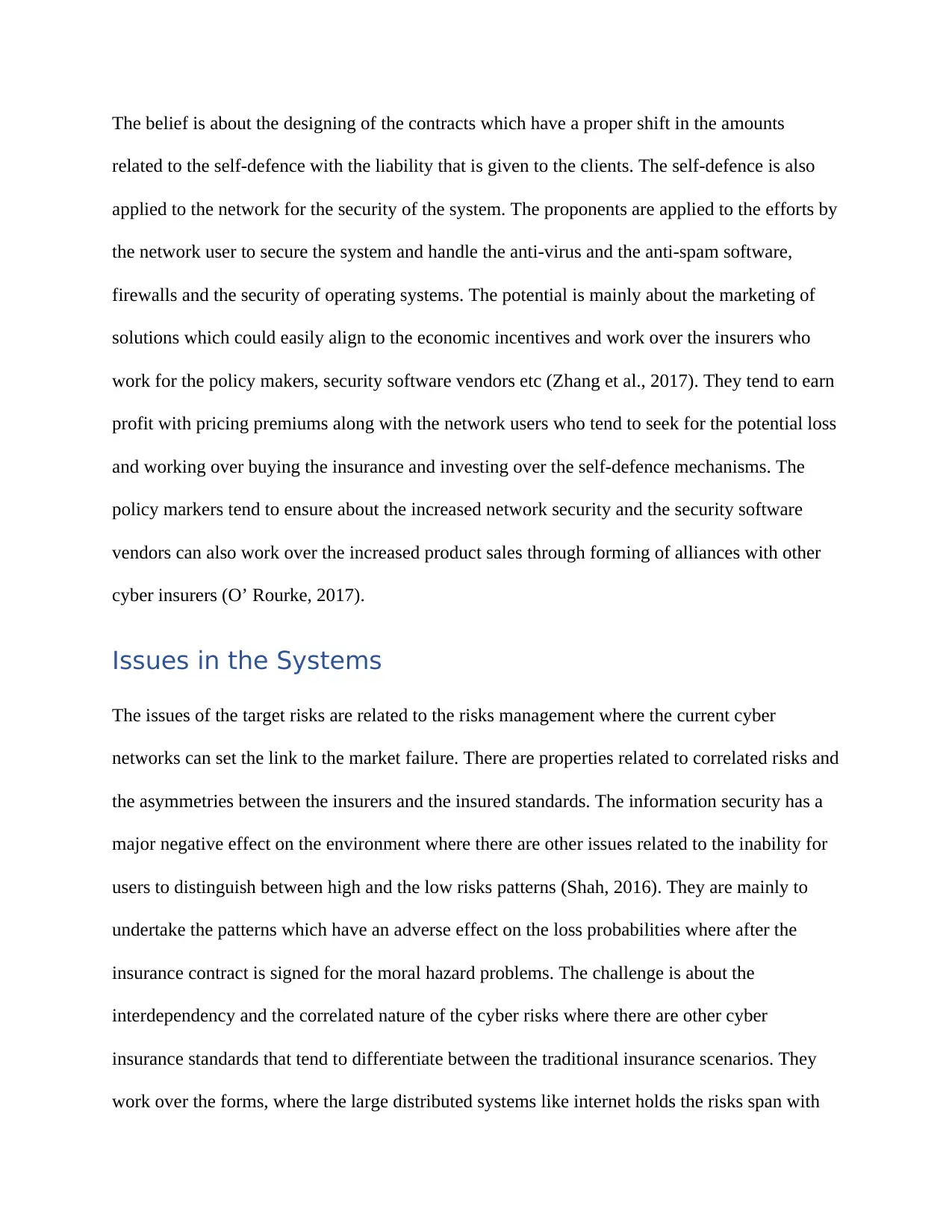
The belief is about the designing of the contracts which have a proper shift in the amounts
related to the self-defence with the liability that is given to the clients. The self-defence is also
applied to the network for the security of the system. The proponents are applied to the efforts by
the network user to secure the system and handle the anti-virus and the anti-spam software,
firewalls and the security of operating systems. The potential is mainly about the marketing of
solutions which could easily align to the economic incentives and work over the insurers who
work for the policy makers, security software vendors etc (Zhang et al., 2017). They tend to earn
profit with pricing premiums along with the network users who tend to seek for the potential loss
and working over buying the insurance and investing over the self-defence mechanisms. The
policy markers tend to ensure about the increased network security and the security software
vendors can also work over the increased product sales through forming of alliances with other
cyber insurers (O’ Rourke, 2017).
Issues in the Systems
The issues of the target risks are related to the risks management where the current cyber
networks can set the link to the market failure. There are properties related to correlated risks and
the asymmetries between the insurers and the insured standards. The information security has a
major negative effect on the environment where there are other issues related to the inability for
users to distinguish between high and the low risks patterns (Shah, 2016). They are mainly to
undertake the patterns which have an adverse effect on the loss probabilities where after the
insurance contract is signed for the moral hazard problems. The challenge is about the
interdependency and the correlated nature of the cyber risks where there are other cyber
insurance standards that tend to differentiate between the traditional insurance scenarios. They
work over the forms, where the large distributed systems like internet holds the risks span with
related to the self-defence with the liability that is given to the clients. The self-defence is also
applied to the network for the security of the system. The proponents are applied to the efforts by
the network user to secure the system and handle the anti-virus and the anti-spam software,
firewalls and the security of operating systems. The potential is mainly about the marketing of
solutions which could easily align to the economic incentives and work over the insurers who
work for the policy makers, security software vendors etc (Zhang et al., 2017). They tend to earn
profit with pricing premiums along with the network users who tend to seek for the potential loss
and working over buying the insurance and investing over the self-defence mechanisms. The
policy markers tend to ensure about the increased network security and the security software
vendors can also work over the increased product sales through forming of alliances with other
cyber insurers (O’ Rourke, 2017).
Issues in the Systems
The issues of the target risks are related to the risks management where the current cyber
networks can set the link to the market failure. There are properties related to correlated risks and
the asymmetries between the insurers and the insured standards. The information security has a
major negative effect on the environment where there are other issues related to the inability for
users to distinguish between high and the low risks patterns (Shah, 2016). They are mainly to
undertake the patterns which have an adverse effect on the loss probabilities where after the
insurance contract is signed for the moral hazard problems. The challenge is about the
interdependency and the correlated nature of the cyber risks where there are other cyber
insurance standards that tend to differentiate between the traditional insurance scenarios. They
work over the forms, where the large distributed systems like internet holds the risks span with
Paraphrase This Document
Need a fresh take? Get an instant paraphrase of this document with our AI Paraphraser
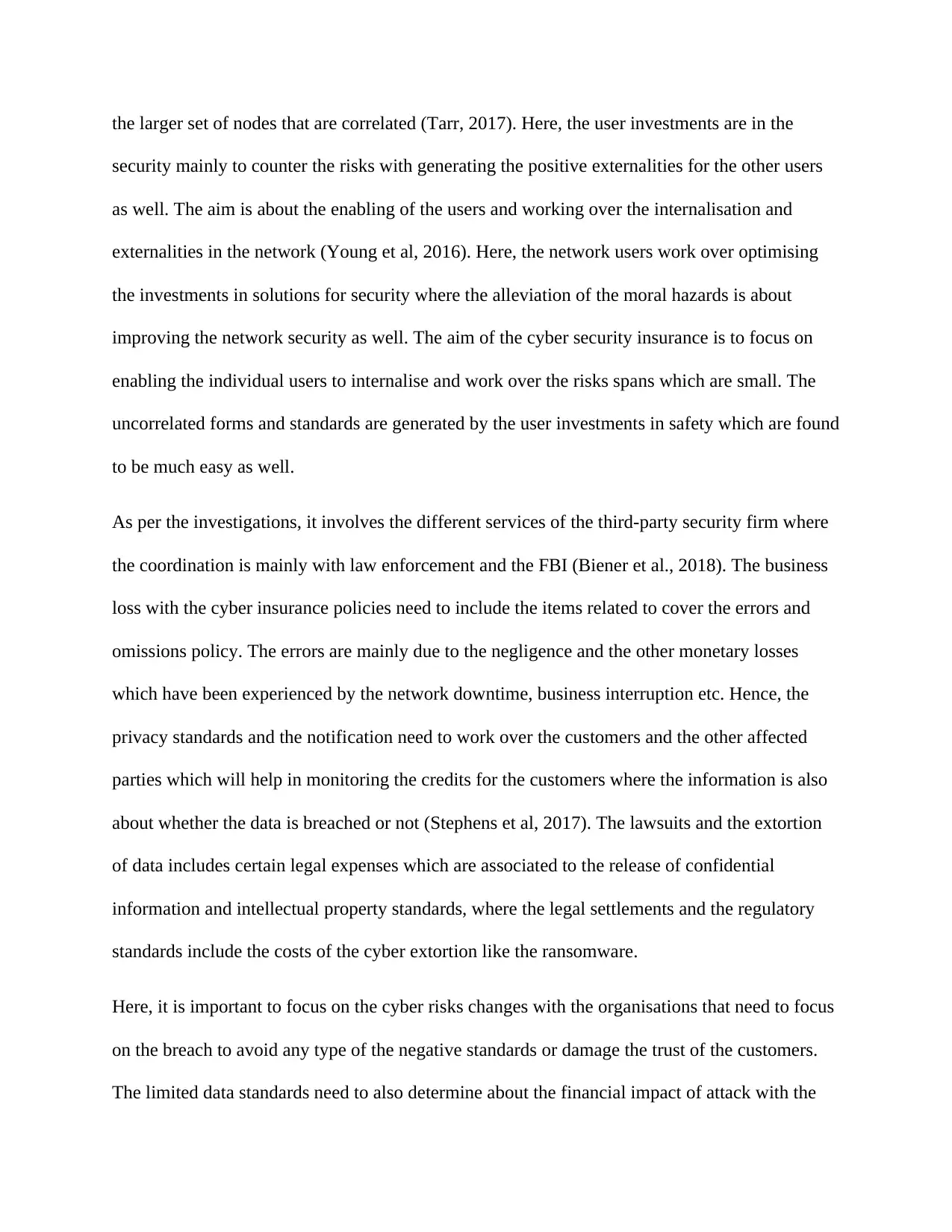
the larger set of nodes that are correlated (Tarr, 2017). Here, the user investments are in the
security mainly to counter the risks with generating the positive externalities for the other users
as well. The aim is about the enabling of the users and working over the internalisation and
externalities in the network (Young et al, 2016). Here, the network users work over optimising
the investments in solutions for security where the alleviation of the moral hazards is about
improving the network security as well. The aim of the cyber security insurance is to focus on
enabling the individual users to internalise and work over the risks spans which are small. The
uncorrelated forms and standards are generated by the user investments in safety which are found
to be much easy as well.
As per the investigations, it involves the different services of the third-party security firm where
the coordination is mainly with law enforcement and the FBI (Biener et al., 2018). The business
loss with the cyber insurance policies need to include the items related to cover the errors and
omissions policy. The errors are mainly due to the negligence and the other monetary losses
which have been experienced by the network downtime, business interruption etc. Hence, the
privacy standards and the notification need to work over the customers and the other affected
parties which will help in monitoring the credits for the customers where the information is also
about whether the data is breached or not (Stephens et al, 2017). The lawsuits and the extortion
of data includes certain legal expenses which are associated to the release of confidential
information and intellectual property standards, where the legal settlements and the regulatory
standards include the costs of the cyber extortion like the ransomware.
Here, it is important to focus on the cyber risks changes with the organisations that need to focus
on the breach to avoid any type of the negative standards or damage the trust of the customers.
The limited data standards need to also determine about the financial impact of attack with the
security mainly to counter the risks with generating the positive externalities for the other users
as well. The aim is about the enabling of the users and working over the internalisation and
externalities in the network (Young et al, 2016). Here, the network users work over optimising
the investments in solutions for security where the alleviation of the moral hazards is about
improving the network security as well. The aim of the cyber security insurance is to focus on
enabling the individual users to internalise and work over the risks spans which are small. The
uncorrelated forms and standards are generated by the user investments in safety which are found
to be much easy as well.
As per the investigations, it involves the different services of the third-party security firm where
the coordination is mainly with law enforcement and the FBI (Biener et al., 2018). The business
loss with the cyber insurance policies need to include the items related to cover the errors and
omissions policy. The errors are mainly due to the negligence and the other monetary losses
which have been experienced by the network downtime, business interruption etc. Hence, the
privacy standards and the notification need to work over the customers and the other affected
parties which will help in monitoring the credits for the customers where the information is also
about whether the data is breached or not (Stephens et al, 2017). The lawsuits and the extortion
of data includes certain legal expenses which are associated to the release of confidential
information and intellectual property standards, where the legal settlements and the regulatory
standards include the costs of the cyber extortion like the ransomware.
Here, it is important to focus on the cyber risks changes with the organisations that need to focus
on the breach to avoid any type of the negative standards or damage the trust of the customers.
The limited data standards need to also determine about the financial impact of attack with the
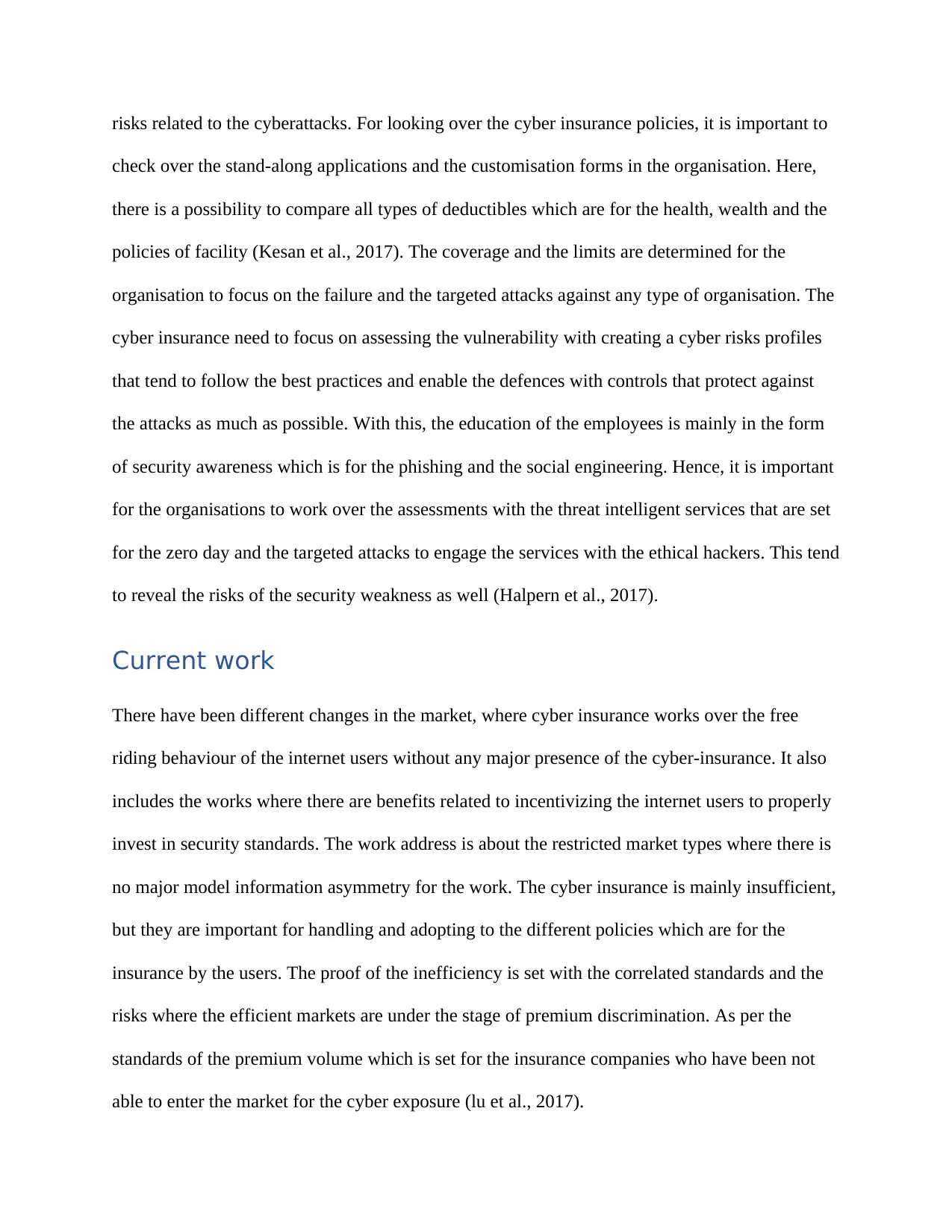
risks related to the cyberattacks. For looking over the cyber insurance policies, it is important to
check over the stand-along applications and the customisation forms in the organisation. Here,
there is a possibility to compare all types of deductibles which are for the health, wealth and the
policies of facility (Kesan et al., 2017). The coverage and the limits are determined for the
organisation to focus on the failure and the targeted attacks against any type of organisation. The
cyber insurance need to focus on assessing the vulnerability with creating a cyber risks profiles
that tend to follow the best practices and enable the defences with controls that protect against
the attacks as much as possible. With this, the education of the employees is mainly in the form
of security awareness which is for the phishing and the social engineering. Hence, it is important
for the organisations to work over the assessments with the threat intelligent services that are set
for the zero day and the targeted attacks to engage the services with the ethical hackers. This tend
to reveal the risks of the security weakness as well (Halpern et al., 2017).
Current work
There have been different changes in the market, where cyber insurance works over the free
riding behaviour of the internet users without any major presence of the cyber-insurance. It also
includes the works where there are benefits related to incentivizing the internet users to properly
invest in security standards. The work address is about the restricted market types where there is
no major model information asymmetry for the work. The cyber insurance is mainly insufficient,
but they are important for handling and adopting to the different policies which are for the
insurance by the users. The proof of the inefficiency is set with the correlated standards and the
risks where the efficient markets are under the stage of premium discrimination. As per the
standards of the premium volume which is set for the insurance companies who have been not
able to enter the market for the cyber exposure (lu et al., 2017).
check over the stand-along applications and the customisation forms in the organisation. Here,
there is a possibility to compare all types of deductibles which are for the health, wealth and the
policies of facility (Kesan et al., 2017). The coverage and the limits are determined for the
organisation to focus on the failure and the targeted attacks against any type of organisation. The
cyber insurance need to focus on assessing the vulnerability with creating a cyber risks profiles
that tend to follow the best practices and enable the defences with controls that protect against
the attacks as much as possible. With this, the education of the employees is mainly in the form
of security awareness which is for the phishing and the social engineering. Hence, it is important
for the organisations to work over the assessments with the threat intelligent services that are set
for the zero day and the targeted attacks to engage the services with the ethical hackers. This tend
to reveal the risks of the security weakness as well (Halpern et al., 2017).
Current work
There have been different changes in the market, where cyber insurance works over the free
riding behaviour of the internet users without any major presence of the cyber-insurance. It also
includes the works where there are benefits related to incentivizing the internet users to properly
invest in security standards. The work address is about the restricted market types where there is
no major model information asymmetry for the work. The cyber insurance is mainly insufficient,
but they are important for handling and adopting to the different policies which are for the
insurance by the users. The proof of the inefficiency is set with the correlated standards and the
risks where the efficient markets are under the stage of premium discrimination. As per the
standards of the premium volume which is set for the insurance companies who have been not
able to enter the market for the cyber exposure (lu et al., 2017).
⊘ This is a preview!⊘
Do you want full access?
Subscribe today to unlock all pages.

Trusted by 1+ million students worldwide
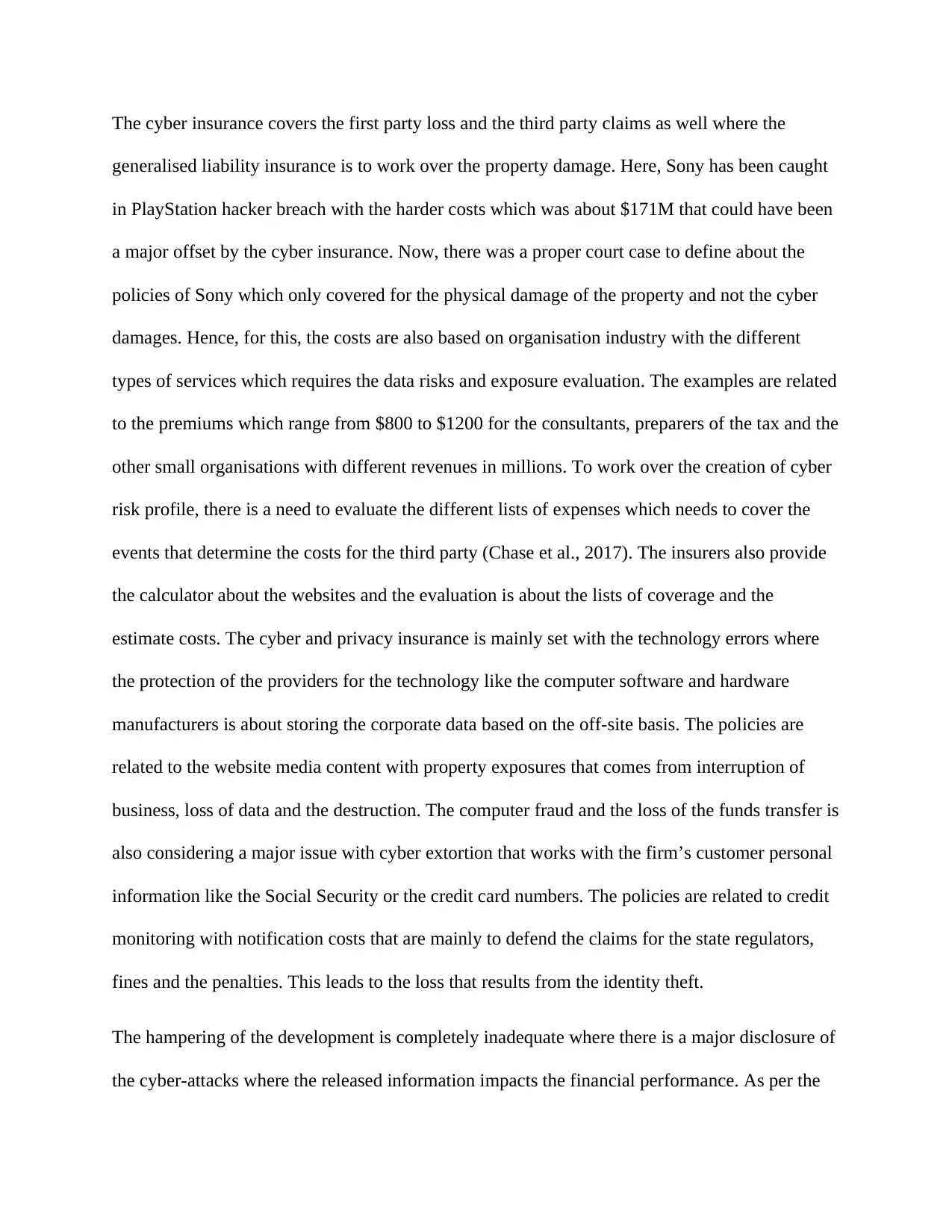
The cyber insurance covers the first party loss and the third party claims as well where the
generalised liability insurance is to work over the property damage. Here, Sony has been caught
in PlayStation hacker breach with the harder costs which was about $171M that could have been
a major offset by the cyber insurance. Now, there was a proper court case to define about the
policies of Sony which only covered for the physical damage of the property and not the cyber
damages. Hence, for this, the costs are also based on organisation industry with the different
types of services which requires the data risks and exposure evaluation. The examples are related
to the premiums which range from $800 to $1200 for the consultants, preparers of the tax and the
other small organisations with different revenues in millions. To work over the creation of cyber
risk profile, there is a need to evaluate the different lists of expenses which needs to cover the
events that determine the costs for the third party (Chase et al., 2017). The insurers also provide
the calculator about the websites and the evaluation is about the lists of coverage and the
estimate costs. The cyber and privacy insurance is mainly set with the technology errors where
the protection of the providers for the technology like the computer software and hardware
manufacturers is about storing the corporate data based on the off-site basis. The policies are
related to the website media content with property exposures that comes from interruption of
business, loss of data and the destruction. The computer fraud and the loss of the funds transfer is
also considering a major issue with cyber extortion that works with the firm’s customer personal
information like the Social Security or the credit card numbers. The policies are related to credit
monitoring with notification costs that are mainly to defend the claims for the state regulators,
fines and the penalties. This leads to the loss that results from the identity theft.
The hampering of the development is completely inadequate where there is a major disclosure of
the cyber-attacks where the released information impacts the financial performance. As per the
generalised liability insurance is to work over the property damage. Here, Sony has been caught
in PlayStation hacker breach with the harder costs which was about $171M that could have been
a major offset by the cyber insurance. Now, there was a proper court case to define about the
policies of Sony which only covered for the physical damage of the property and not the cyber
damages. Hence, for this, the costs are also based on organisation industry with the different
types of services which requires the data risks and exposure evaluation. The examples are related
to the premiums which range from $800 to $1200 for the consultants, preparers of the tax and the
other small organisations with different revenues in millions. To work over the creation of cyber
risk profile, there is a need to evaluate the different lists of expenses which needs to cover the
events that determine the costs for the third party (Chase et al., 2017). The insurers also provide
the calculator about the websites and the evaluation is about the lists of coverage and the
estimate costs. The cyber and privacy insurance is mainly set with the technology errors where
the protection of the providers for the technology like the computer software and hardware
manufacturers is about storing the corporate data based on the off-site basis. The policies are
related to the website media content with property exposures that comes from interruption of
business, loss of data and the destruction. The computer fraud and the loss of the funds transfer is
also considering a major issue with cyber extortion that works with the firm’s customer personal
information like the Social Security or the credit card numbers. The policies are related to credit
monitoring with notification costs that are mainly to defend the claims for the state regulators,
fines and the penalties. This leads to the loss that results from the identity theft.
The hampering of the development is completely inadequate where there is a major disclosure of
the cyber-attacks where the released information impacts the financial performance. As per the
Paraphrase This Document
Need a fresh take? Get an instant paraphrase of this document with our AI Paraphraser
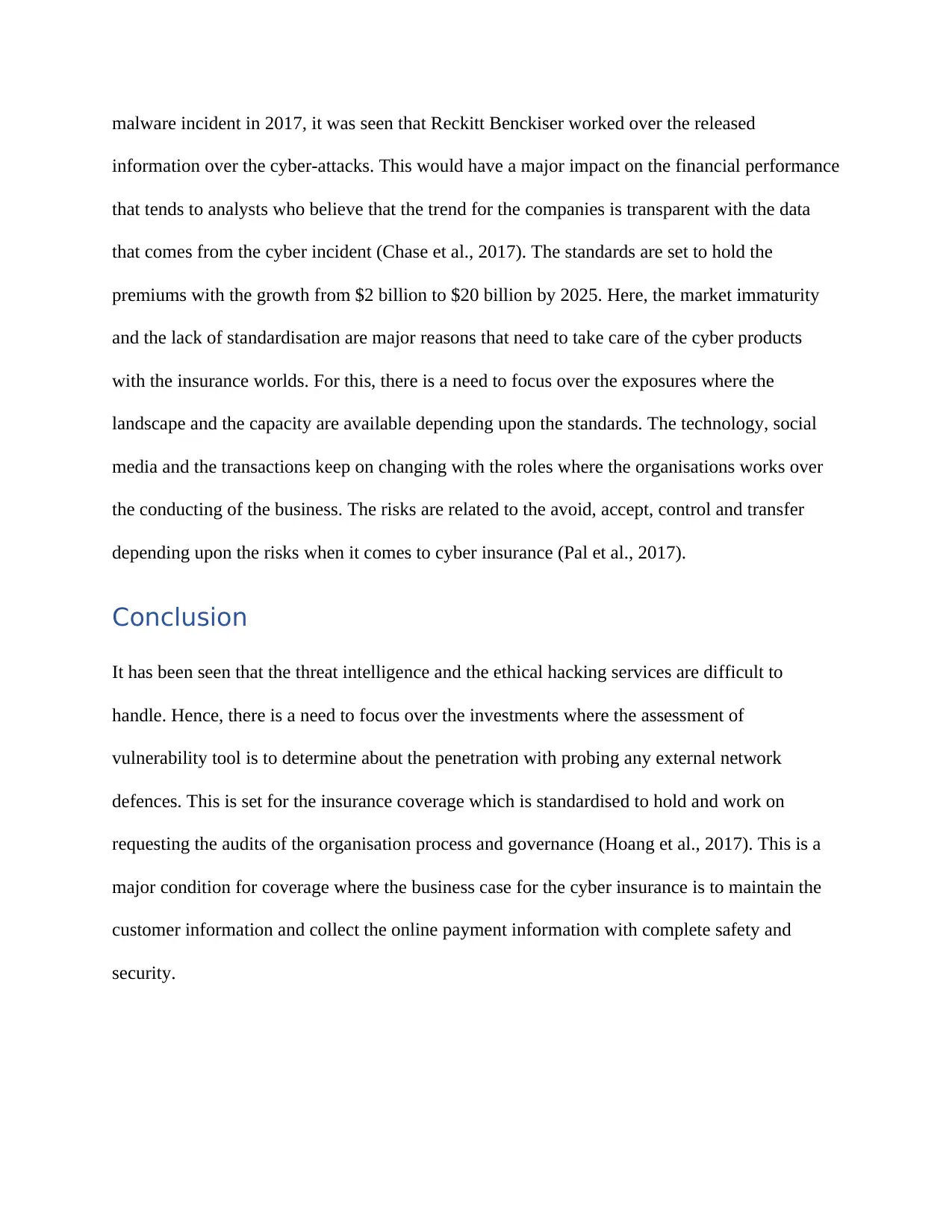
malware incident in 2017, it was seen that Reckitt Benckiser worked over the released
information over the cyber-attacks. This would have a major impact on the financial performance
that tends to analysts who believe that the trend for the companies is transparent with the data
that comes from the cyber incident (Chase et al., 2017). The standards are set to hold the
premiums with the growth from $2 billion to $20 billion by 2025. Here, the market immaturity
and the lack of standardisation are major reasons that need to take care of the cyber products
with the insurance worlds. For this, there is a need to focus over the exposures where the
landscape and the capacity are available depending upon the standards. The technology, social
media and the transactions keep on changing with the roles where the organisations works over
the conducting of the business. The risks are related to the avoid, accept, control and transfer
depending upon the risks when it comes to cyber insurance (Pal et al., 2017).
Conclusion
It has been seen that the threat intelligence and the ethical hacking services are difficult to
handle. Hence, there is a need to focus over the investments where the assessment of
vulnerability tool is to determine about the penetration with probing any external network
defences. This is set for the insurance coverage which is standardised to hold and work on
requesting the audits of the organisation process and governance (Hoang et al., 2017). This is a
major condition for coverage where the business case for the cyber insurance is to maintain the
customer information and collect the online payment information with complete safety and
security.
information over the cyber-attacks. This would have a major impact on the financial performance
that tends to analysts who believe that the trend for the companies is transparent with the data
that comes from the cyber incident (Chase et al., 2017). The standards are set to hold the
premiums with the growth from $2 billion to $20 billion by 2025. Here, the market immaturity
and the lack of standardisation are major reasons that need to take care of the cyber products
with the insurance worlds. For this, there is a need to focus over the exposures where the
landscape and the capacity are available depending upon the standards. The technology, social
media and the transactions keep on changing with the roles where the organisations works over
the conducting of the business. The risks are related to the avoid, accept, control and transfer
depending upon the risks when it comes to cyber insurance (Pal et al., 2017).
Conclusion
It has been seen that the threat intelligence and the ethical hacking services are difficult to
handle. Hence, there is a need to focus over the investments where the assessment of
vulnerability tool is to determine about the penetration with probing any external network
defences. This is set for the insurance coverage which is standardised to hold and work on
requesting the audits of the organisation process and governance (Hoang et al., 2017). This is a
major condition for coverage where the business case for the cyber insurance is to maintain the
customer information and collect the online payment information with complete safety and
security.
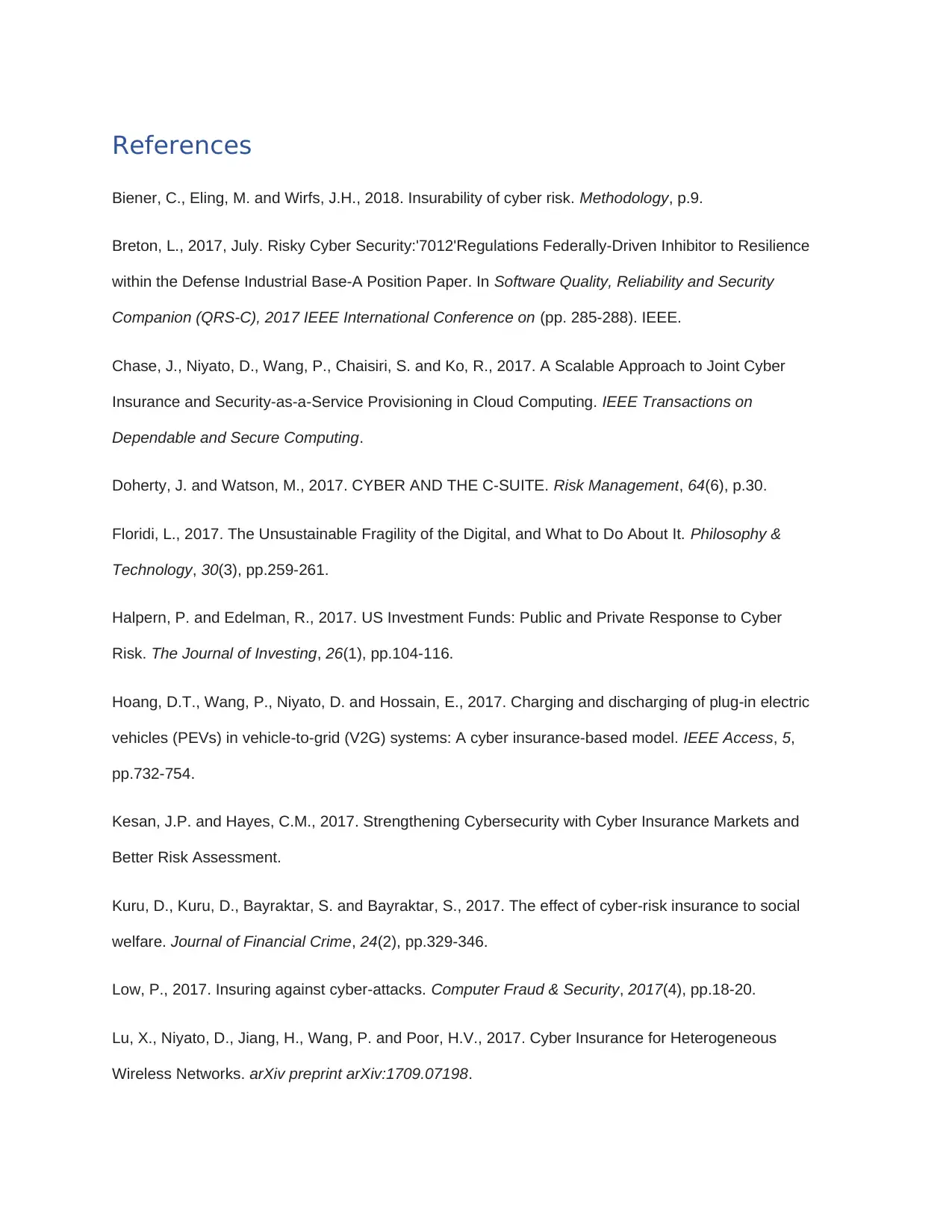
References
Biener, C., Eling, M. and Wirfs, J.H., 2018. Insurability of cyber risk. Methodology, p.9.
Breton, L., 2017, July. Risky Cyber Security:'7012'Regulations Federally-Driven Inhibitor to Resilience
within the Defense Industrial Base-A Position Paper. In Software Quality, Reliability and Security
Companion (QRS-C), 2017 IEEE International Conference on (pp. 285-288). IEEE.
Chase, J., Niyato, D., Wang, P., Chaisiri, S. and Ko, R., 2017. A Scalable Approach to Joint Cyber
Insurance and Security-as-a-Service Provisioning in Cloud Computing. IEEE Transactions on
Dependable and Secure Computing.
Doherty, J. and Watson, M., 2017. CYBER AND THE C-SUITE. Risk Management, 64(6), p.30.
Floridi, L., 2017. The Unsustainable Fragility of the Digital, and What to Do About It. Philosophy &
Technology, 30(3), pp.259-261.
Halpern, P. and Edelman, R., 2017. US Investment Funds: Public and Private Response to Cyber
Risk. The Journal of Investing, 26(1), pp.104-116.
Hoang, D.T., Wang, P., Niyato, D. and Hossain, E., 2017. Charging and discharging of plug-in electric
vehicles (PEVs) in vehicle-to-grid (V2G) systems: A cyber insurance-based model. IEEE Access, 5,
pp.732-754.
Kesan, J.P. and Hayes, C.M., 2017. Strengthening Cybersecurity with Cyber Insurance Markets and
Better Risk Assessment.
Kuru, D., Kuru, D., Bayraktar, S. and Bayraktar, S., 2017. The effect of cyber-risk insurance to social
welfare. Journal of Financial Crime, 24(2), pp.329-346.
Low, P., 2017. Insuring against cyber-attacks. Computer Fraud & Security, 2017(4), pp.18-20.
Lu, X., Niyato, D., Jiang, H., Wang, P. and Poor, H.V., 2017. Cyber Insurance for Heterogeneous
Wireless Networks. arXiv preprint arXiv:1709.07198.
Biener, C., Eling, M. and Wirfs, J.H., 2018. Insurability of cyber risk. Methodology, p.9.
Breton, L., 2017, July. Risky Cyber Security:'7012'Regulations Federally-Driven Inhibitor to Resilience
within the Defense Industrial Base-A Position Paper. In Software Quality, Reliability and Security
Companion (QRS-C), 2017 IEEE International Conference on (pp. 285-288). IEEE.
Chase, J., Niyato, D., Wang, P., Chaisiri, S. and Ko, R., 2017. A Scalable Approach to Joint Cyber
Insurance and Security-as-a-Service Provisioning in Cloud Computing. IEEE Transactions on
Dependable and Secure Computing.
Doherty, J. and Watson, M., 2017. CYBER AND THE C-SUITE. Risk Management, 64(6), p.30.
Floridi, L., 2017. The Unsustainable Fragility of the Digital, and What to Do About It. Philosophy &
Technology, 30(3), pp.259-261.
Halpern, P. and Edelman, R., 2017. US Investment Funds: Public and Private Response to Cyber
Risk. The Journal of Investing, 26(1), pp.104-116.
Hoang, D.T., Wang, P., Niyato, D. and Hossain, E., 2017. Charging and discharging of plug-in electric
vehicles (PEVs) in vehicle-to-grid (V2G) systems: A cyber insurance-based model. IEEE Access, 5,
pp.732-754.
Kesan, J.P. and Hayes, C.M., 2017. Strengthening Cybersecurity with Cyber Insurance Markets and
Better Risk Assessment.
Kuru, D., Kuru, D., Bayraktar, S. and Bayraktar, S., 2017. The effect of cyber-risk insurance to social
welfare. Journal of Financial Crime, 24(2), pp.329-346.
Low, P., 2017. Insuring against cyber-attacks. Computer Fraud & Security, 2017(4), pp.18-20.
Lu, X., Niyato, D., Jiang, H., Wang, P. and Poor, H.V., 2017. Cyber Insurance for Heterogeneous
Wireless Networks. arXiv preprint arXiv:1709.07198.
⊘ This is a preview!⊘
Do you want full access?
Subscribe today to unlock all pages.

Trusted by 1+ million students worldwide
1 out of 14
Related Documents
Your All-in-One AI-Powered Toolkit for Academic Success.
+13062052269
info@desklib.com
Available 24*7 on WhatsApp / Email
![[object Object]](/_next/static/media/star-bottom.7253800d.svg)
Unlock your academic potential
Copyright © 2020–2025 A2Z Services. All Rights Reserved. Developed and managed by ZUCOL.




